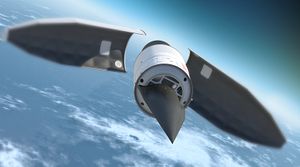The U.S. Army is moving quickly to develop and test new long-range strike weapons in the early 2020s, with plans to test a ground-based hypersonic missile by 2023 and prototype a super-cannon with a planned range of 1,000 miles.
The U.S. Army, Navy, and Air Force are all working on hypersonic weapons with major shared components, with the army designing the maneuverable warhead likely to be used by all three services. One of the principle reasons the United States says it needs these weapons is to defend against similar long-range and hypersonic weapons being developed or already fielded by China and Russia. While the United States is exploring possible space-based and laser weapons to complement its missile defenses, their viability against hypersonic weapons is doubtful. A 2016 study concluded that the only likely way to defend against hypersonic weapons was for the United States to use its own hypersonic weapons to destroy its adversaries’ weapons before they are launched. The Pentagon’s chief of research and development has said recently that the United States cannot intercept hypersonic weapons in the air and they will need to be destroyed on the ground.
The army’s ground-launched hypersonic weapon will have a range of 1,400 miles and thus would have been banned under the Intermediate Nuclear Forces treaty between the United States and Russia, which prohibits ground-launched missiles with ranges between 500 and 5,500 kilometers. The United States has long held that Russia was in breach of the treaty with weapons like its 9M729 missiles, and in February announced that it intended to withdraw. A month later, Russia announced that it was officially suspending its participation in the treaty.
The navy and air force’s sea-launched and air-launched variants were not affected by the INF treaty and the army’s Strategic Long Range Cannon would also have been exempt because it is an artillery system and not a missile system. That system will utilize proven artillery principles and technologies but scaled-up to be able to fire guided, rocket-assisted artillery shells up to 1,000 miles.
The U.S. secretary of the army mused earlier this year that the new long-range strike weapons being developed could be used in a potential South China Sea clash against China’s warships and artificial island bases. At a media roundtable in January, he said, “We can – from a fixed location, on an island or some other place – engage enemy targets, naval targets, at great distances and maintain our standoff and yet open the door, if you will, for naval assets or Marine assets.”
Since at least 2016, the U.S. Navy has been pushing to “get the army to sink a ship” and develop weapons it could use to contribute to the navy’s historic sea control mission. In 2018 the army launched ground-based anti-ship cruise missiles and artillery rockets at a target hulk during the Rim of the Pacific Exercise. The army’s hypersonic missile is more likely to be used against important land targets like long-range sensors, headquarters, or an adversary’s own hypersonic weapons, but if the army can provide its new long-range artillery with a viable anti-ship capability it could be a crucial asset to complement navy and marine operations in littoral and archipelagic environments.
The key for all the long-range weapons being developed by the U.S. military, especially those intended to be used against maneuvering targets like ships, will be to have a robust enough sensor network to successfully guide those weapons to their targets. A missile or artillery shell may have 1,000-plus miles of range, but the sensors required to guide them may have to be much closer to the targets.

































